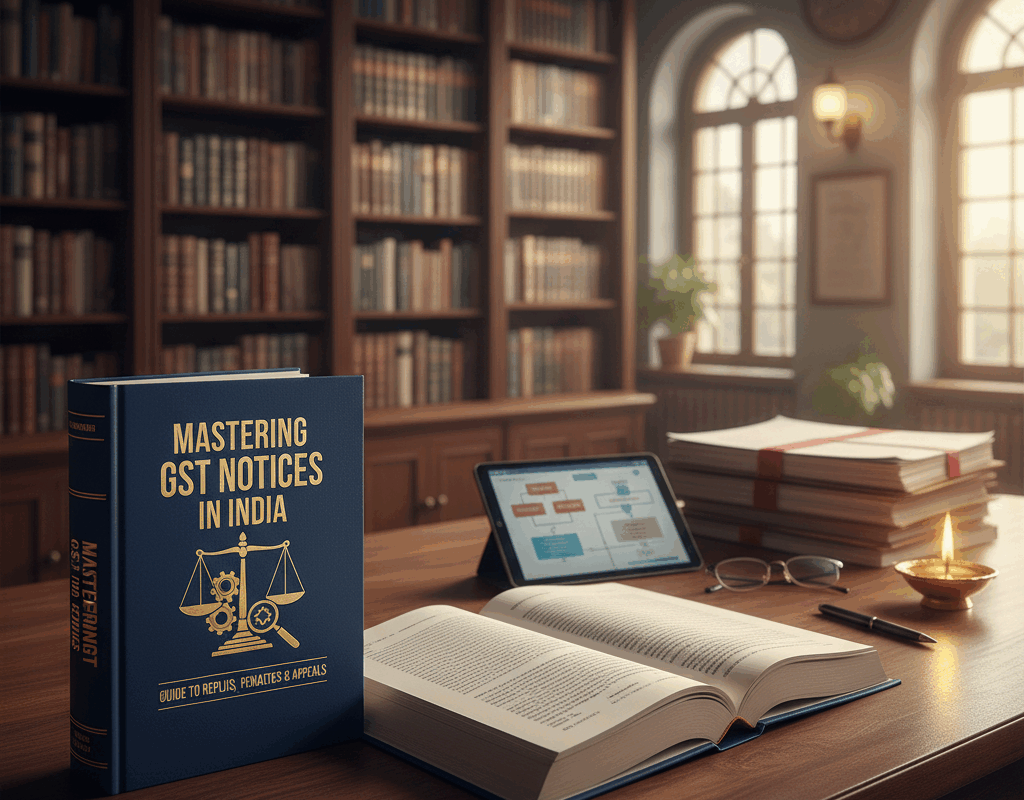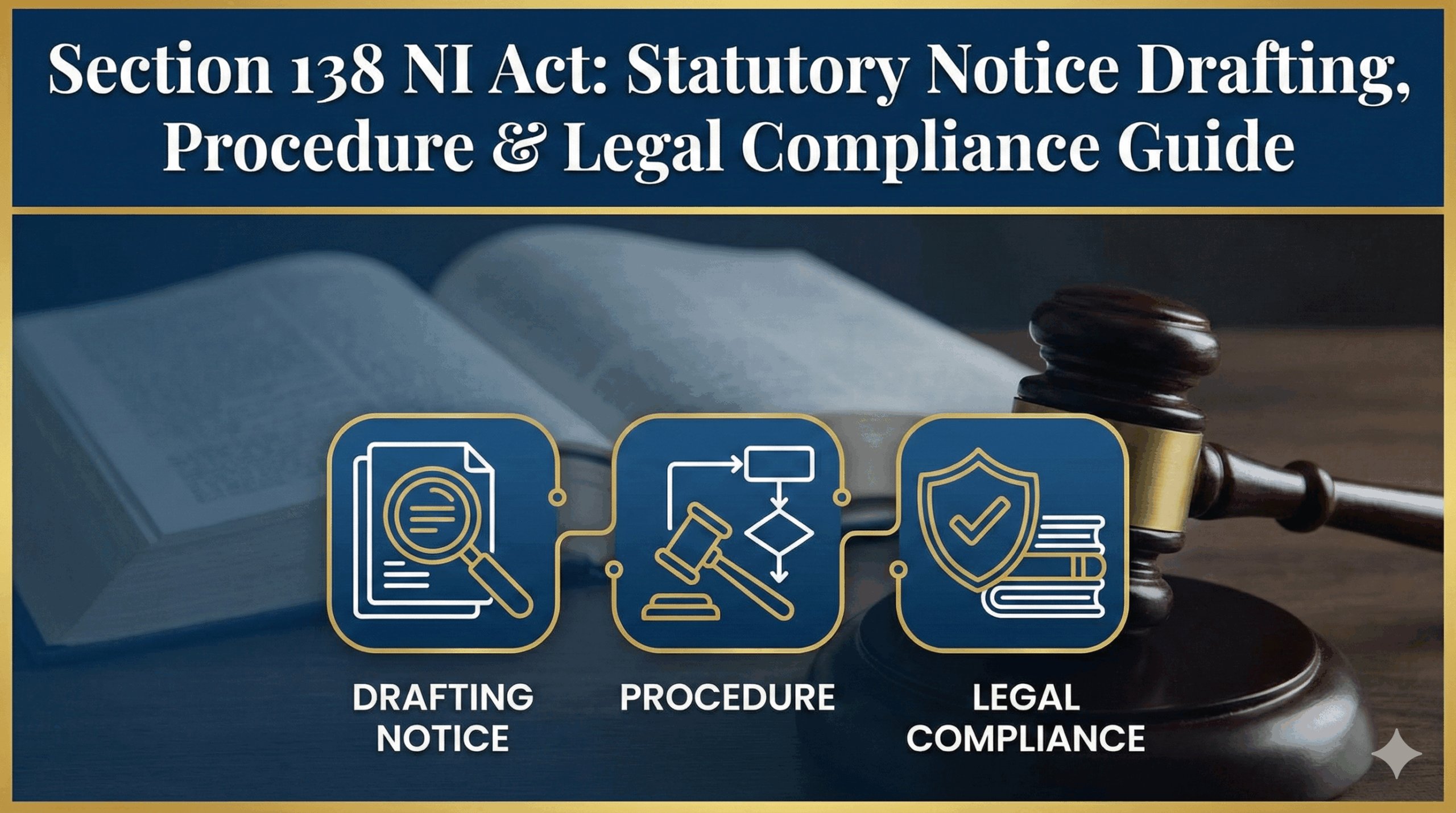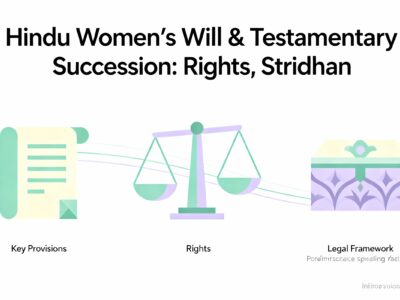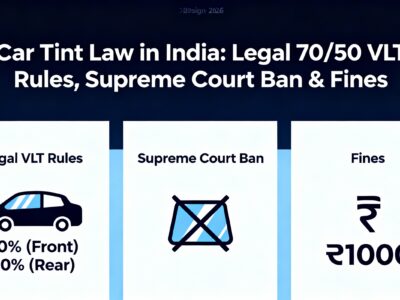Receiving a GST notice can be a stressful experience for any business in India. Whether it’s a scrutiny notice in Form ASMT-10 for discrepancies in your returns or a formal Show Cause Notice (SCN) like DRC-01, a timely and well-drafted reply is critical to safeguarding your interests. This comprehensive 2025 guide provides a legal practitioner’s insight into the entire GST notice ecosystem. We will explore the different types of GST notices, from return defaulter notices in GSTR-3A to demands involving fraud under Section 74, and provide a clear Standard Operating Procedure (SOP) for an effective response. Understanding the nuances between a non-fraudulent demand under Section 73 and the severe consequences of a fraud-based one is paramount for effective GST compliance and litigation strategy. This article will equip you with the knowledge to navigate the adjudication process, manage penalties, and build a robust defense.
A Legal Practitioner's Guide to Navigating GST Notices in India
Strategy, Compliance, and Response for Businesses
Last Updated: September 2025
Table of Contents
- The Anatomy and Genesis of a GST Notice
- A Comprehensive Typology of GST Notices
- The Standard Operating Procedure for an Effective Response
- Mastering the Art of the Written Reply
- The Perils of Inaction: Consequences of Non-Compliance
- Judicial Precedents and Advanced Legal Strategies
- Seeking Professional Counsel and Official Resources
- The Adjudication Process & Personal Hearings
- Post-Adjudication Remedies: The Appellate Pathway
- Technology's Double-Edged Sword in GST Compliance
- Frequently Asked Questions (FAQ)
Part I: The Anatomy and Genesis of a GST Notice
Section 1.1: Decoding the Communication
Under the Goods and Services Tax (GST) regime in India, a notice is a formal communication issued by the tax authorities to a registered taxpayer. It serves various purposes, from reminding a taxpayer of a pending compliance obligation to initiating proceedings for the determination of tax liability. A critical preliminary check for any recipient is to verify the jurisdiction and authority of the issuing officer. A notice issued by an officer without the proper jurisdiction can be challenged as legally invalid.
Infographic: Valid Modes of Serving a GST Notice
Hand-delivery
Registered Post / Courier
Registered Email
GST Portal
Newspaper
Affixing at Business
Section 1.2: Common Triggers and Risk Parameters
The issuance of a GST notice is rarely random. It is typically triggered by specific red flags or risk parameters identified by the tax authorities, often through automated systems. The GST regime is built upon a foundation of interconnected digital filings, creating a digital "three-way handshake" for most transactions.
Infographic: Common Triggers for GST Notices
Discrepancies in Returns
Mismatches between GSTR-1 (outward supplies) and GSTR-3B (summary return).
Input Tax Credit (ITC) Mismatches
Variances between ITC claimed in GSTR-3B and available credit in GSTR-2B.
Delayed or Non-Filing of Returns
Failure to file GSTR-1 or GSTR-3B for consecutive tax periods.
Discrepancy with Income Tax Returns (ITR)
Significant difference between turnover in GST returns and revenue in ITR.
E-Way Bill Non-Compliance
Mismatches between e-way bill data and GSTR-1 declarations.
Section 1.3: The Mandate of a Document Identification Number (DIN)
To enhance transparency and prevent unauthorized communication from tax officials, the Central Board of Indirect Taxes and Customs (CBIC) has mandated the quoting of a computer-generated Document Identification Number (DIN) on all communications sent to taxpayers. Any notice, order, or summons issued without a valid DIN is legally considered invalid or "non-est," meaning it has no legal standing. The taxpayer can verify the authenticity of the DIN on the CBIC's online portal. This is a crucial first check upon receiving any communication.
Part II: A Comprehensive Typology of GST Notices
Section 2.1: Master Table of Common GST Notices
| Form No. | Purpose | Time Limit | Consequences |
|---|---|---|---|
| GSTR-3A | Notice to Return Defaulter for not filing GSTR-1/3B/4/8. | 15 days to file the return. | Best Judgment Assessment under Section 62, Penalty of ₹10,000 or tax due, whichever is higher. |
| ASMT-10 | Notice for discrepancies identified during the scrutiny of returns under Section 61. | 30 days (or as specified). | If explanation is unsatisfactory, may lead to audit, special audit, or demand under Sec 73/74. |
| DRC-01A | Intimation of tax liability before a formal Show Cause Notice (Part A) for pre-litigation consultation. | As specified. | Opportunity to pay tax/interest to avoid SCN. If unpaid, DRC-01 (SCN) will be issued. |
| DRC-01 | Formal Show Cause Notice (SCN) for Demand of Tax under Section 73 or 74. | 30 days from the date of service. | If no reply or unsatisfactory reply, an adverse order will be passed, followed by recovery proceedings. |
| REG-03 | Notice seeking additional information/clarification for GST Registration or Amendment application. | 7 working days. | Rejection of the GST registration/amendment application. |
| REG-17 | Show Cause Notice for Cancellation of GST Registration for specified contraventions. | 7 working days. | GST registration will be cancelled from a specified date, potentially with retrospective effect. |
| ADT-01 | Notice for the conduct of a departmental audit under Section 65. | Not less than 15 working days prior to the audit. | Non-cooperation can lead to penalties and best judgment assessment. |
| RFD-08 | Notice seeking clarification regarding a refund application filed in RFD-01. | 15 days. | Rejection of the refund claim if the response is unsatisfactory or not provided. |
Section 2.2: The Critical Divide: Notices Under Section 73 (Non-Fraud) vs. Section 74 (Fraud)
The choice of section invoked by the department fundamentally alters the nature of the proceedings, the financial stakes, and the legal strategy required. Section 73 is for genuine errors, while Section 74 is for cases involving fraud, willful misstatement, or suppression of facts.
Comparison: Section 73 vs. Section 74
Section 73 (Non-Fraud)
- Basis: Genuine errors, omissions.
- Time Limit for SCN: 2 years, 9 months.
- Penalty: 10% of tax or ₹10,000.
- Concession: No penalty if tax+interest paid within 30 days of SCN.
Section 74 (Fraud)
- Basis: Fraud, willful misstatement.
- Time Limit for SCN: 4 years, 6 months.
- Penalty: 100% of tax.
- Concession: Penalty reduces to 25% if paid within 30 days of SCN.
Interactive Chart: Penalty Concessions
Part III: SOP for an Effective Response
Section 3.1: The First 48 Hours
The initial hours after receiving a GST notice are critical for setting the stage for a successful resolution. A panicked or delayed reaction can lead to errors and missed deadlines.
Infographic: First 48 Hours Action Plan
-
Acknowledge & Verify
Never ignore a notice. Verify GSTIN and legal name.
-
Analyze the Notice
Understand the issue, legal sections cited, and demand amount.
-
Calendar the Deadline
Immediately note the due date to avoid missing it.
-
Consult a Professional
Engage a GST consultant, CA, or lawyer for complex cases.
Section 3.2: The GST Notice Response Workflow
A systematic approach ensures that all aspects of the notice are addressed comprehensively and a robust defense is prepared.
Infographic: The GST Notice Response Workflow
Receive & Analyze
Check DIN, jurisdiction, and deadline.
Gather Data
Collect returns, invoices, agreements, etc.
Draft Reply
Prepare factual and legal submissions.
Review & Finalize
Internal/external review for accuracy.
Submit & Follow Up
File on portal/offline & keep records.
Part IV: Mastering the Art of the Written Reply
Drafting a response is not merely about providing information; it is about constructing a persuasive legal and factual argument. A well-structured reply is easier to read, understand, and adjudicate.
Infographic: Anatomy of an Effective Reply
Taxpayer details, date, addressee, and a precise subject line.
Acknowledge receipt of the notice and state the purpose of the reply.
Present the background and facts of the case from your perspective.
Address each allegation from the notice separately, referencing evidence.
Cite relevant laws, rules, and court judgments to support your case.
Summarize and request to drop proceedings. Ask for a personal hearing.
Section 4.2: Common Legal Defenses and Arguments
Beyond factual clarifications, certain legal principles form the bedrock of a strong defense against a GST notice. Deploying these arguments requires a nuanced understanding of tax jurisprudence.
- Principle of Natural Justice: Arguing that the notice is vague, does not provide sufficient details, or that an adequate opportunity to be heard was not provided. This is a fundamental right in quasi-judicial proceedings.
- Limitation Period: Challenging the notice on the grounds that it has been issued beyond the statutory time limits prescribed under Section 73 (approx. 3 years) or Section 74 (approx. 5 years) from the due date of the annual return.
- Revenue Neutrality: This argument is applicable in situations where any tax paid by one unit of a company would be available as a full Input Tax Credit (ITC) to another unit of the same company. The argument is that the entire exercise is revenue-neutral for the government, and thus, a demand is not justified.
- Interpretation of Law: Contesting the department's interpretation of a specific GST provision, notification, or circular. This is common in cases involving classification of goods/services or the eligibility of an exemption.
- Lack of Mens Rea: In cases under Section 74 (fraud), a key defense is to prove the absence of a guilty mind or intent to evade tax ('mens rea'). Demonstrating that any discrepancy was due to a bona fide error or technical glitch can help contest the harsh penalties associated with fraud.
Section 4.3: Annotated Templates
The following templates provide a practical starting point for drafting replies.
Template 1: Reply to Scrutiny Notice (Form ASMT-10)
To,
The [Designation of Officer],
[Address of Officer]
**Subject: Reply to Notice in Form GST ASMT-10...**
Respected Sir/Madam,
1. This letter is in response to the notice...
2. Our submissions are as follows:
(a) Discrepancy 1: [State the discrepancy]
Our Clarification: [Provide your explanation]
(Refer to Annexure-1)
(b) Discrepancy 2: ...
3. ...we submit that there has been no short payment of tax.
4. Prayer: We humbly request... to drop the proceedings.
Yours faithfully,
For [Your Company Name]
Part V: The Perils of Inaction
Failure to respond to a GST notice sets in motion a cascade of adverse consequences that can inflict significant financial and operational damage on a business.
Section 5.2: Operational Disruption
Perhaps the most crippling consequence of sustained non-compliance is the potential for the suspension and subsequent cancellation of the business's GST registration.
Infographic: The Domino Effect of Non-Compliance
1. Notice Ignored
Failure to file returns/reply
2. SCN Issued
Form REG-17 for cancellation
3. Registration Cancelled
Business operations halt
4. Recovery Initiated
Bank accounts attached
Section 5.3: Drastic Measures: Provisional Attachment & ITC Blocking
In certain circumstances, particularly where significant revenue is at stake and there is a perceived risk of default, the GST authorities are empowered to take severe preemptive measures even before the adjudication process is complete.
Provisional Attachment (Section 83)
The Commissioner can order the provisional attachment of any property, including bank accounts, belonging to the taxpayer to protect government revenue. This can paralyze a business's operations by freezing its working capital. It is typically invoked during the pendency of proceedings under sections like 62, 63, 64, 67, 73, or 74.
Blocking of ITC (Rule 86A)
The department can block a taxpayer from utilizing the Input Tax Credit available in their electronic credit ledger if they have "reason to believe" that the ITC has been fraudulently availed or is ineligible. This directly impacts the taxpayer's ability to discharge their output tax liability, increasing their cash outflow.
Part VI: Judicial Precedents and Advanced Legal Strategies
The Indian judiciary plays a crucial role in interpreting the nuances of GST law. Leveraging key rulings can significantly strengthen a taxpayer's defense.
"The issuance of a notice in Form ASMT-10 is a mandatory pre-requisite before issuing a Show Cause Notice under Section 73 for scrutiny of returns."- Gauhati High Court, TS-821-HC(GAUH)-2025-GST
"The department cannot invoke the serious charge of fraud merely to take advantage of the extended period of limitation."- Allahabad High Court, TS-806-HC(ALL)-2025-GST
Part VII: Seeking Professional Counsel
While this guide is comprehensive, the complexities of tax law often necessitate professional assistance. Knowing when to seek help is crucial.
When to Engage a Professional
- Notices with significant tax demands.
- Any notice under Section 74 (fraud).
- Complex legal interpretation issues.
- Departmental audits or investigations.
Official Resources
Part VIII: The Adjudication Process & Personal Hearings
Section 8.1: From Reply to Order-in-Original
Submitting a written reply does not mark the end of the process. The Proper Officer will review your submissions and evidence. If the officer is not satisfied with the reply, they are required to grant an opportunity for a personal hearing before passing a final order, known as an Order-in-Original (OIO).
The personal hearing is a critical stage. It is an opportunity to orally present your case, clarify complex points from your written submission, and respond to any further queries from the adjudicating authority. Proper preparation is paramount.
Section 8.2: The Doctrine of Audi Alteram Partem
A cornerstone of legal fairness is the principle of Audi Alteram Partem, which means "let the other side be heard." The GST law incorporates this principle of natural justice. An adverse order cannot be passed against a taxpayer without giving them an opportunity to present their case. If an order is passed without granting a personal hearing (especially when requested), it can be challenged in a higher forum as a violation of natural justice.
Checklist for Personal Hearing
- Prepare a Synopsis: Create a brief summary of your main arguments, referencing key evidence and legal precedents.
- Organize a Paper Book: Compile an indexed set of all relevant documents, including the notice, reply, annexures, and case laws.
- Anticipate Questions: Think through the potential questions the officer might ask and prepare clear, concise answers.
- Seek Adjournment if Necessary: If you need more time to gather information, you can request an adjournment, though these are granted at the officer's discretion (a maximum of three adjournments are typically allowed).
- Record Submissions: After the hearing, it is good practice to submit a brief written summary of the arguments made and points discussed during the hearing.
Part IX: Post-Adjudication Remedies: The Appellate Pathway
If the Order-in-Original passed by the adjudicating authority is unfavorable, the taxpayer is not without recourse. The GST framework provides a structured, multi-tiered appellate mechanism to challenge such orders.
Infographic: The GST Appellate Hierarchy & Timelines
First Appellate Authority
Appeal must be filed within 3 months from the date of the order. A pre-deposit of 10% of the disputed tax amount is mandatory.
GST Appellate Tribunal (GSTAT)
Appeal against the first appellate order within 3 months. An additional pre-deposit of 20% of the disputed tax is required.
High Court
Appeal against the GSTAT order if it involves a substantial question of law. Time limits are governed by the High Court's rules.
Supreme Court
The final court of appeal. An appeal can be filed against a High Court order, or directly from a GSTAT order in certain cases involving place of supply.
Part X: Technology's Double-Edged Sword in GST Compliance
The GST regime is technology-driven, which cuts both ways. The same technology that enables seamless compliance also empowers the tax authorities with powerful tools for data analytics, risk profiling, and identifying non-compliance.
The Department's Arsenal
- AI & Machine Learning: Algorithms analyze vast datasets to flag high-risk taxpayers and suspicious transaction patterns.
- Data Triangulation: Systems cross-reference data from GST returns, ITR, e-way bills, and bank information to detect discrepancies.
- Social Network Analysis: Tools to identify networks of shell companies and circular trading used for fraudulent ITC claims.
The Taxpayer's Toolkit
- Advanced Reconciliation Software:Automated tools to perform multi-way reconciliations (e.g., GSTR-1 vs 3B vs Books) to ensure data accuracy.
- GST Compliance Dashboards: Real-time dashboards to monitor compliance health, track notice statuses, and manage deadlines.
- Proactive Analytics: Using internal data analytics to identify potential discrepancies before they are flagged by the department.
Part XI: Frequently Asked Questions (FAQ)
Even if the deadline has passed, you should still attempt to file a reply at the earliest. While the officer is not legally obligated to consider a late reply, they often do, especially if an order has not yet been passed. You can also file a request for condonation of delay, explaining the reasons for the late submission.
You cannot revise a previously filed GST return. However, you can rectify errors in a subsequent return (e.g., report a missed invoice or correct an incorrect one). If you have received a notice, you should pay the tax and interest via Form DRC-03 and explain this in your reply. This shows bona fide intent and can lead to reduced or waived penalties, especially in non-fraud cases.
While not strictly mandatory, it is highly advisable to attend the personal hearing, either in person or through an authorized representative (like a CA or lawyer). It is your best opportunity to present your case directly to the decision-maker and clarify any doubts they may have. Not attending can lead to an ex-parte order based solely on the information available to the officer.
Cultivating a Culture of Compliance
Receiving a GST notice can be daunting, but a structured, informed, and proactive approach can lead to a successful resolution. The most effective strategy is to minimize the chances of receiving one by embedding a culture of rigorous compliance, data integrity, and meticulous record-keeping within your organization.










